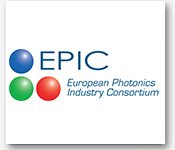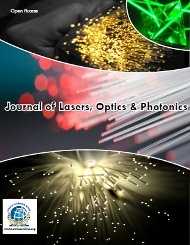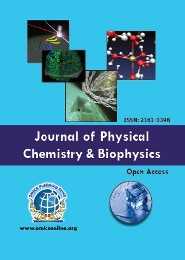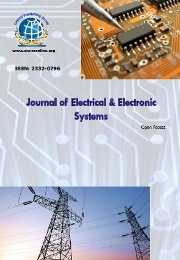Theme: Advancing research and Featuring technologies in Lasers, Optics and Photonics
Optics-2015

Dear Colleagues,
On behalf of the OMICS group conferences, it is my pleasure to invite all of the great scientists from all over the world to attend the 3rd International Conference and Exhibition on Laser, Optics, and Photonics from September 01-03, 2015 in Valencia, Spain.
This conference started in 2013 and was held in San Antonio, Texas, USA. It was held again in 2014 in Philadelphia, Pennsylvania. Both conferences shared an insight into the recent research and cutting edge technologies in Lasers, Optics, and Photonics which gained immense interest with the colossal and exuberant presence of adepts, young and brilliant researchers, business delegates and talented student communities representing more than 22 countries.
Based upon the strong success of these first two conferences, a third conference will be held in 2015. The Optics 2015 meeting’s goal is to bring together, once-more, a multi-disciplinary group of scientists and engineers from all over the world to present and exchange break-through ideas relating to the applied physics and applications of light and matter interactions. It promotes top level research and to globalize the quality research in general, thus making discussions, presentations more internationally competitive and focusing attention on the recent outstanding achievements in the field of lasers, optics and photonics, and future trends and needs.
We’re looking forward to another excellent meeting with great scientists from different countries around the world and sharing new and exciting results in Lasers, Optics and Photonics, which will be held in Spain 2015 from September 01-03.
yours sincerely,
Prof. Manijeh Razeghi
Conference Chair
Center for Quantum Devices
EECS Department, Northwestern University, USA
OMICS International is proud to announce the commencement of “3rd International Conference and Exhibition on Lasers, Optics and Photonics” at Valencia, Spain from September 01-03, 2015. The scientific program concentrates around the theme “Advancing research and featuring technologies in Lasers, Optics and Photonics.” Optics-2015 is an international optics conferences, encompassing clinical, translational, and fundamental research and development in the field of lasers, optics and Photonics. It provides a premier technical forum for reporting and learning about the latest research and development, as well as for launching new applications and technologies. The Organizing committee of Lasers conferences takes the honor of inviting Scientists, Engineers, clinicians, researchers, academicians who work with optics and photonics to solve problems in medicine and biomedicine, Astronomy, ophthalmology and optometry, Application and product developers, Design engineers, Applied researchers, physicians, Young researchers, Business delegates and talented student communities working in the field of Lasers, Optics and Photonics to share their research experiences and indulge in interactive discussions at the event.
OMICS International Organizes 300+ International Conferences every year across USA, Europe & Asia with support from 1000 more scientific societies and Publishes 400+ Open access journals which contains over 30000 eminent personalities, reputed scientists as Editorial Board members.
Spain is a place for wide-scope of research in several areas of photonics, including information technologies, nanophotonic devices, optical sensors, ultrafast optics, optoelectronics and biophotonics. In Spain there are more than 32 Photonic research institutes and nearly 45 Photonic companies. The Spain photonics industry had been experienced a growth rate of 18 percent with a turnover of €1.4 billion. Currently there are more than 40 cluster members, many of which are heavily involved in research activities. The membership represents 35 percent of the current photonics industry in Chicago. Based on the latest advancements and researches OMICS Group is organizing this international conference in Valencia to share and discuss on the current technologies and arrive with new thoughts for the implementation of current trends in research for better technology. There are numerous photonics conferences occur every year across the Spain.
For more information, please visit: Optics Market Analysis
Scientific sessions:
Track 1: Advanced Science and Technology for Laser Systems
A laser is a device that emits light through a process of optical amplification based on the stimulated emission of electromagnetic radiation. The term "laser" originated as an acronym for "light amplification by stimulated emission of radiation". Among their many applications, lasers are used in optical disk drives, laser printers, and barcode scanners; fiber-optic and free-space optical communication; laser surgery and skin treatments; cutting and welding materials; military and law enforcement devices for marking targets and measuring range and speed; and laser lighting displays in entertainment. The Worldwide Market for Lasers - Market Review and Forecast 2015. The overall laser market grew by more than 6% in 2014, with fiber lasers growing by more than 16%. Learn more in this new report which will analyse each application and provide forecasts for units, ASP, and revenues by laser type through 2019. Also included are estimates of market share for the major players. Many laser symposiums are taking place across the world to share knowledge on latest advancements in Laser technology. Laser science or laser physics and photonics are branches of physics that look at the theory and applications of lasers and optic light.
Track 2: Optics and Lasers in Medicine
Optical imaging is an imaging technique. Conferences on Optics usually describes the behaviour of visible, ultraviolet, and infrared light used in imaging. Because light is an electromagnetic wave, similar phenomena occur in X-rays, microwaves, radio waves. Chemical imaging or molecular imaging involves inference from the deflection of light emitted from (e.g. laser, infrared) source to structure, texture, anatomic and chemical properties of material (e.g. crystal, cell tissue). Optical imaging systems may be divided into diffusive and ballistic imaging systems. Diffusive Optical Imaging (DOI) also known as Near-Infrared Optical tomography (NIROT), Diffuse Optical Tomography (DOT) or Optical Diffusion Tomography (ODT) is a technique that gives neuroscientists the ability to simultaneously obtain information about the source of neural activity as well as its time course, allowing to "see" neural activity and study the functioning of the brain. In this method, a near-infrared laser is positioned on the scalp. Detectors composed of optical fiber bundles are located a few centimeters away from the light source. These detectors sense how the path of light is altered, either through absorption or scattering, as it traverses brain tissue. This method can provide two types of information. First, it can be used to measure the absorption of light, which is related to concentration of chemicals in the brain. Second, it can measure the scattering of light, which is related to physiological characteristics such as the swelling of glia and neurons that are associated with neuronal firing. There are many optics meetings are taking place across the world to share knowledge on latest advancements in optics events. The medical category, currently the second-largest segment of the AO market, is expected to move at a CAGR of 89.5%, reaching $9.4 billion by 2022. One of the drivers of this growth is the technology's success in in-vivo cell research, which can be extended to real-time patient monitoring.
Optoelectronics is the study and application of electronic devices that source, detect and control light, usually considered a sub-field of photonics. In this context, light often includes invisible forms of radiation such as gamma rays, X-rays, ultraviolet and infrared, in addition to visible light. Optoelectronic devices are electrical-to-optical or optical-to-electrical transducers, or instruments that use such devices in their operation. Electro-optics is often erroneously used as a synonym, but is a wider branch of physics that concerns all interactions between light and electric fields, whether or not they form part of an electronic device. Optoelectronics is based on the quantum mechanical effects of light on electronic materials, especially semiconductors, sometimes in the presence of electric fields. Photoelectric or photovoltaic effect, used in: photodiodes (including solar cells), phototransistors, photomultipliers, optoisolators, integrated optical circuit (IOC) elements. Optoelectronoic Applications: Photoconductivity, used in: photo resistors, photoconductive camera tubes, charge-coupled imaging devices. The Optoelectronics market is expected to grow at a CAGR of 18% from 2012 to 2020, and reach $4.21 billion in 2020.
Track 4: Optical Communications and Networking
Fiber-optic communication is a method of transmitting information from one place to another by sending pulses of light through an optical fiber. The light forms an electromagnetic carrier wave that is modulated to carry information. First developed in the 1970s, fiber-optic communication systems have revolutionized the telecommunications industry and have played a major role in the advent of the Information Age. Because of its advantages over electrical transmission, optical fibers have largely replaced copper wire communications in core networks in the developed world. Optics fiber is used by many telecommunications companies to transmit telephone signals, Internet communication, and cable television signals. The process of communicating using fiber-optics involves the following basic steps: Creating the optical signal involving the use of a transmitter, relaying the signal along the fiber, ensuring that the signal does not become too distorted or weak, receiving the optical signal, and converting it into an electrical signal. Extrinsic fiber optic sensors use an optical fiber cable, normally a multimode one, to transmit modulated light from either a non-fiber optical sensor, or an electronic sensor connected to an optical transmitter.
Track 5: Advancements in Photonics
Photonics science includes the generation, emission, transmission, modulation, signal processing, switching, amplification, and detection/sensing of light. Though covering all light's technical applications over the whole spectrum, most photonic applications are in the range of visible and near-infrared light. The term photonics developed as an outgrowth of the first practical semiconductor light emitters invented in the early 1960s and optical fibers developed in the 1970s. Photonics also relates to the emerging science of quantum information, in those cases where it employs photonic methods. Other emerging fields include opto-atomics, in which devices integrate both photonic and atomic devices for applications such as precision timekeeping, navigation, and metrology; polaritonics, which differs from photonics in that the fundamental information carrier is a polariton, which is a mixture of photons and phonons, and operates in the range of frequencies from 300 gigahertz to approximately 10 terahertz. Applications of photonics are ubiquitous. Included are all areas from everyday life to the most advanced science, e.g. light detection, telecommunications, information processing, lighting, metrology, spectroscopy, holography, medicine (surgery, vision correction, endoscopy, health monitoring), military technology, laser material processing, visual art, biophotonics, agriculture, and robotics. photonics components market comprises 2,750 companies in 46 countries, generating $156bn in revenues annually. There are many photonics symposiums take place across the world to share and to learn latest advancements in photonics. The market size for photonics technology is expected to reach to $29.84 Billion by 2020, growing at a CAGR of 25.39% from 2014 to 2020.
Track 6: Nanophotonics and Biophotonics
Nanophotonics is the study of the behaviour of light on the nanometer scale, and of the interaction of nanometer-scale objects with light. It is a branch of optics, optical engineering, electrical engineering, and nanotechnology. It often (but not exclusively) involves metallic components, which can transport and focus light via surface plasmon polaritons. Biophotonics can also be described as the "development and application of optical techniques, particularly imaging, to the study of biological molecules, cells and tissue". One of the main benefits of using optical techniques which make up biophotonics is that they preserve the integrity of the biological cells being examined. Biophotonics can be used to study biological materials or materials with properties similar to biological material, i.e., scattering material, on a microscopic or macroscopic scale. On the microscopic scale common applications include microscopy and optical coherence tomography. On the macroscopic scale, the light is diffuse and applications commonly deal with diffuse optical imaging and tomography (DOI and DOT). In microscopy, the development and refinement of the confocal microscope, the fluorescence microscope, and the total internal reflection fluorescence microscope all belong to the field of biophotonics.
Track 7: Quantum Science and Technology
A quantum sensor is a device that exploits quantum correlations, such as quantum entanglement, to achieve a sensitivity or resolution that is better than can achieved using only classical systems. A quantum sensor can measure the effect of the quantum state of another system on itself. The mere act of measurement influences the quantum state and alters the probability and uncertainty associated with its state during measurement. The Defence Advanced Research Projects Agency has recently launched a research program in optical quantum sensors that seeks to exploit ideas from quantum metrology and quantum imaging, such as quantum lithography and the NOON state, in order to achieve these goals with optical sensor systems such as lidar. Quantum sensor is also a term used in other settings where entangled quantum systems are exploited to make better atomic clocks or more sensitive magnetometers. Quantum Photonics is to explore fundamental aspects of quantum mechanics, as well as work towards future photonic quantum technologies by generating, manipulating and measuring single photons as well as the quantum systems that emit these photons. The market for quantum dots based products, such as new television screens, is projected to reach $3.5 billion by 2020. The majority of this growth will come from increased demand in the US.
Track 8: Featured Technologies in Lasers, Optics and Photonics
Fiber-optic communication is a method of transmitting information from one place to another by sending pulses of light through an optical fiber. The light forms an electromagnetic carrier wave that is modulated to carry information. First developed in the 1970s, fiber-optic communication systems have revolutionized the telecommunications industry and have played a major role in the advent of the Information Age. Because of its advantages over electrical transmission, optical fibers have largely replaced copper wire communications in core networks in the developed world. Optical fiber is used by many telecommunications companies to transmit telephone signals, Internet communication, and cable television signals. Semiconductor lasers or laser diodes play an important part in our everyday lives by providing cheap and compact-size lasers. They consist of complex multi-layer structures requiring nanometer scale accuracy and an elaborate design. Their theoretical description is important not only from a fundamental point of view, but also in order to generate new and improved designs. The description can be done at various levels of accuracy and effort, resulting in different levels of understanding. It is common to all systems that the laser is an inverted carrier density system. The carrier inversion results in an electromagnetic polarization which drives an electric field. In most cases, the electric field is confined in a resonator, the properties of which are also important factors for laser performance. Silicon photonics is the study and application of photonic systems which use silicon as an optical medium. The silicon is usually patterned with sub-micrometre precision, into microphotonic components. These operate in the infrared, most commonly at the 1.55 micrometre wavelength used by most fiber optic telecommunication systems. The silicon typically lies on top of a layer of silica in what (by analogy with a similar construction in microelectronics) is known as silicon on insulator (SOI). There are numerous conferences on optics occur every year across the globe which share latest advancements in the field of optics physics. The fiber optics market is expected to grow at a CAGR of 5.1% between 2014 and 2019 to reach a value of $3.0 billion.
Track 9: Applications and Trends in Optics and Photonics
Applications of photonics are ubiquitous. Included are all areas from everyday life to the most advanced science, e.g. light detection, telecommunications, information processing, lighting, metrology, spectroscopy, holography, medicine (surgery, vision correction, endoscopy, health monitoring), military technology, laser material processing, visual art, biophotonics, agriculture, and robotics. Just as applications of electronics have expanded dramatically since the first transistor was invented in 1948, the unique applications of photonics continue to emerge. Economically important applications for semiconductor photonic devices include optical data recording, fiber optic telecommunications, laser printing (based on xerography), displays, and optical pumping of high-power lasers. The potential applications of photonics are virtually unlimited and include chemical synthesis, medical diagnostics, on-chip data communication, laser defence, and fusion energy. The science of photonics includes investigation of the emission, transmission, amplification, detection, and modulation of light. The silicon photonics market is expected to grow to $497.53 million by 2020, growing at a CAGR of 27.74% from 2014 to 2020. Adaptive optics (AO) is a technology used to improve the performance of optical systems by reducing the effect of wave front distortions: it aims at correcting the deformations of an incoming wave front by deforming a mirror in order to compensate for the distortion. It is used in astronomical telescopes and laser communication systems to remove the effects of atmospheric distortion, in microscopy, optical fabrication and in retinal imaging systems to reduce optical aberrations. Adaptive optics works by measuring the distortions in a wave front and compensating for them with a device that corrects those errors such as a deformable mirror or a liquid crystal array. Global Adaptive Optics Market to Reach $40.7 Billion in 2022; Consumer Segment Expected to Soar to More Than $24 Billion and Over 250% CAGR.
Importance & Scope
Optical science is studied in many related disciplines including astronomy, various engineering fields, photography, and medicine (particularly ophthalmology and optometry). Practical applications of optics are found in a variety of technologies and everyday objects, including mirrors, lenses, telescopes, microscopes, lasers, and fiber optics. In the last 30 years lasers have become generally accepted in science and technology, as well as in industry, medicine, and protection of the environment. Optical systems are ubiquitous in modern society, from Medical sciences to space exploration, telecommunications, information processing and innumerous industrial and military applications of all kinds.
Why Valencia?
Valencia is the capital of the autonomous community of Valencia and the third largest city in Spain after Madrid and Barcelona, with around 809,000 inhabitants in the administrative centre. Valencia is also Spain’s third largest metropolitan area, with a population ranging from 1.7 to 2.5 million. The city has global city status; the Port of Valencia is the 5th busiest container port in Europe and the largest on the Mediterranean Sea, with a trade volume of 4.21 million.
Valencia was founded as a Roman colony in 138 BC. The city is situated on the banks of the Turia, on the east coast of the Iberian Peninsula, fronting the Gulf of Valencia on the Mediterranean Sea. Its historic centre is one of the largest in Spain, with approximately 169 acres; this heritage of ancient monuments, views and cultural attractions makes Valencia one of the country’s most popular tourist destinations filled with vibrant and historical places. In Valencia a wide-scope of research take place in several areas of photonics, including information technologies, nanophotonic devices, optical sensors, ultrafast optics, optoelectronics and biophotonics. Currently there are more than 32 Photonic research institutes and nearly 45 Photonic companies.
Valencia is the centre of international and avant-garde design, and one of the most bustling cities in Europe regarding fairs and conferences. This city is an industrial centre which expanded its cultural and touristic possibilities, and transformed it into a newly vibrant city. Many restored local landmarks including the ancient Towers of the medieval city (Serrano Towers and Quart Towers), the San Miguel de los Reyes monastery holding a conservation library and whole sections of the old city, for example the Carmen Quarter are centre of attraction.
Conference Highlights
- Advanced Science and Technology for Laser Systems
- Optics and Lasers in Medicine
- Optoelectronics Engineering
- Optical Communications and Networking
- Advancements in Photonics
- Nanophotonics and Biophotonics
- Quantum Science and Technology
- Featured Technologies in Lasers, Optics and Photonics
- Applications and Trends in Optics and Photonics
Why to attend???
3rd International Conference and Exhibition on Lasers, Optics & Photonics is an international optics conference encompassing clinical, translational, and fundamental research and its involvement for the development in the field of lasers, optics and Photonics. It provides a premier technical forum for reporting and learning about the latest research and development, along with launching new applications and technologies. Events include hot topics presentations from all over the world and professional networking with industries, leading working groups and panels.
A Unique Opportunity for Advertisers and Sponsors at this International event:
http://optics.conferenceseries.com/sponsors.php
Major Optics Associations in Europe
European Acoustics Association (EAA)
European Biophysical Societies' Association (EBSA)
European Colloid and Interface Society (ECIS)
European Federation of Organizations for Medical Physics (EFOMP)
European Group for Atomic Spectroscopy (EGAS)
European Optical Society (EOS)
Target Audience
Researchers, Engineers, academicians who work with optics and photonics to solve problems in medicine and biomedicine, Astronomy, ophthalmology and optometry, Application and product developers, Design engineers, Nanoscience Engineers, Organic Photonical researchers, Electronic and Optical Engineers and talented student community from leading Universities.
Top Universities in Spain
University of Barcelona
University of La Laguna
Autonomous University of Barcelona
University of Madrid
The University of Cantabria
Top Photonics Companies in Spain
DAS Photonics
Geo Semiconductor Inc
VLC Photonics
Fotonica
Glance at Market of Lasers, Optics & Photonics
Laser applications range from commodity optics for LED lighting and smart phones to exotic and custom optics for microlithography and astronomy, and infrared to ultraviolet applications. Several of the leading photonics companies in the world views on different technologies, and opinions about future challenges and opportunities for manufacturers and integrators of lasers and photonics products.
For more information, please visit: Optics Market Analysis
Conference Highlights
- Advanced Science and Technology for Laser Systems
- Optics and Lasers in Medicine
- Optoelectronics
- Optical Communications and Networking
- Advancements in Photonics
- Nanophotonics and Biophotonics
- Quantum Science and Technology
- Featured Technologies in Lasers, Optics and Photonics
- Applications and Trends in Optics and Photonics
To share your views and research, please click here to register for the Conference.
To Collaborate Scientific Professionals around the World
| Conference Date | September 01-03, 2015 | ||
| Sponsors & Exhibitors |
|
||
| Speaker Opportunity Closed | Day 1 | Day 2 | Day 3 |
| Poster Opportunity Closed | Click Here to View | ||
Useful Links
Special Issues
All accepted abstracts will be published in respective Our International Journals.
- Journal of Lasers, Optics & Photonics
- Journal of Physical Chemistry & Biophysics
- Journal of Electrical & Electronic Systems
Abstracts will be provided with Digital Object Identifier by








